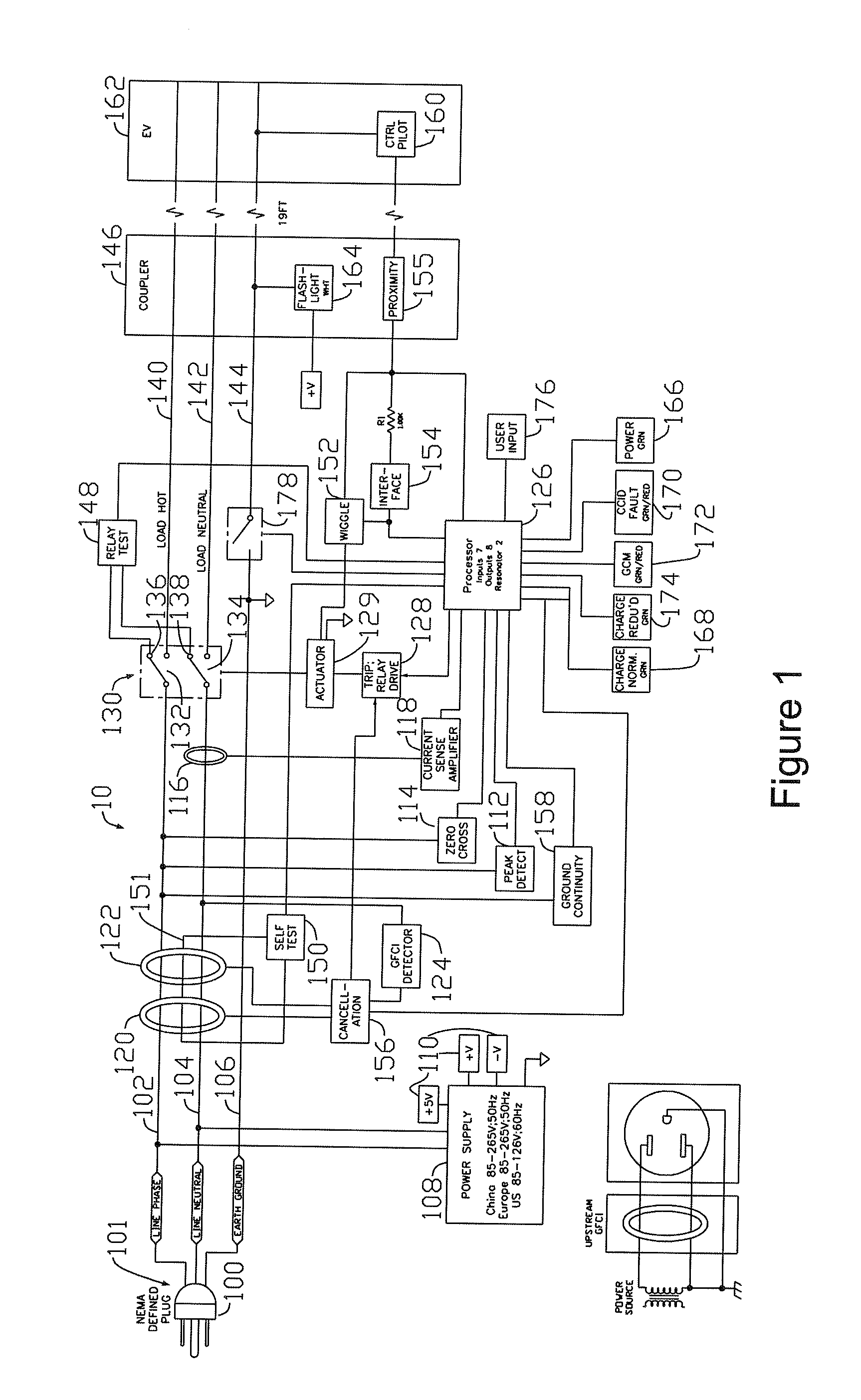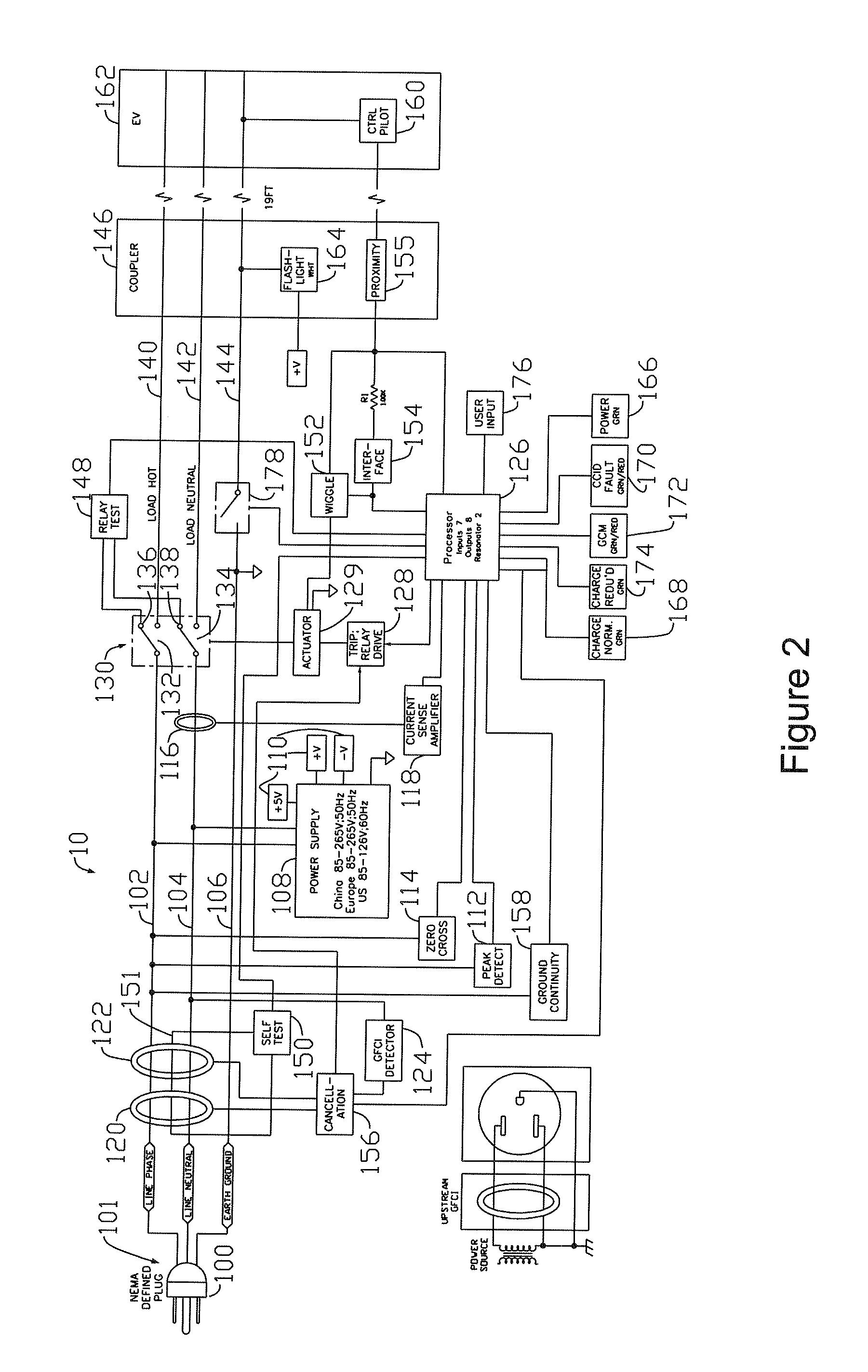Electric vehicles are becoming increasingly popular due to the rising cost of
petroleum, the
air pollution related to the use of petroleum based fuels, and the growing awareness that the supply of oil and gas is limited.
In fact, there are some projections that indicate that the supply of oil and gas could be depleted in the near term.
On the other hand, there are difficulties associated with the
electric vehicle that must be overcome before they become an efficient and effective replacement for conventional gas-powered vehicles.
Electric vehicles typically employ batteries that may take hours to recharge.
For example, the phase circuit wire insulation may become damaged such that the phase conductor contacts the grounded circuit.
As another example, a miswiring condition may occur such that the phase conductor is improperly connected to the ground wire.
An arc fault is a
discharge of
electricity between two or more conductors and may be caused by damaged insulation on a hot line conductor or a
neutral line conductor, or on both a hot line conductor and a
neutral line conductor.
The damaged insulation may cause a low power arc between the two conductors and a fire may result.
A ground fault may also result in fire.
If the wiring insulation within a
load circuit becomes damaged, the hot conductor may contact ground, creating a shock
hazard for a user.
A ground fault may also occur when equipment comes in contact with water.
A ground fault may also be caused by damaged insulation within the electrical
distribution system.
All of these devices serve to interrupt fault currents propagating in the ground circuit before the ground wire becomes overheated, or is compromised by an open circuit condition.
An open circuit in the ground path, therefore, represents an
electrical shock hazard because the current flowing in the ground wire cannot flow to ground when the ground wire is broken.
Instead, the current will seek the best available path to ground and, unfortunately, the best available path to ground might include a
human being.
One drawback to the considered approach is that the GCM allows power to be provided to a load in the presence of a miswired condition or absence of a ground conductor.
One drawback to this approach is that the interconnected circuitry may provide a leakage path.
Of course, this represents a shock hazard.
There is an additional layer of complexity when one considers that each
branch circuit in an electrical
distribution system may be protected by a plurality of protective devices (e.g.,
overcurrent devices, GFCIs, AFCIs, etc.).
Similar issues arise with GFCIs in that they are also commonly located throughout the electrical
distribution system in panels, wiring device wall boxes, attachment plugs, and appliance cords.
Furthermore, the downstream device limits power interruption to a relatively smaller portion of the
branch circuit where the fault hazard is located.
This device is intended to interrupt ground faults that have
high energy; if faults of this type are allowed to persist, they would cause damage to equipment or wiring, and could lead to a fire.
Should there be a discontinuity in the ground circuit, the risk of shock or
electrocution from contacting an energized EV body or frame is considerably greater than the risks associated with an ordinary appliance by virtue of the extensive surface area of the EV body.
Another issue relates to protecting the EV user from the risk of shock during the recharging cycle.
The EV, as well as the
high frequency circuitry associated with the on-board battery charging circuit, is constantly being exposed to mechanical shock, vibration,
moisture and
dirt.
These factors may increase the risk of discontinuity in the ground connection.
On the other hand, during normal operation of the electric vehicle there is
high frequency noise generated by the switch mode power supply, and currents may be directed to ground via electronic
noise filters or other such circuitry.
Even though these currents are safe, they will cause an ordinary 6 mA GFCI to nuisance trip, i.e., an interruption of the charging cycle for non-fault related reasons.
One of the drawbacks associated with the CCID relates to the aforementioned fact that when multiple protective devices are connected in series, it is preferable that the furthest downstream device perform the protective task.
This represents an inherent mismatch for an EV
charging station protected at 20 mA.
Thus, the presence of EV
charging station violates the established device coordination protocol of placing less sensitive protective devices upstream of the relatively sensitive 6 mA GFCIs.
There is also the aforementioned inconvenience of having to walk down to the
basement to reset the tripped device before recommencing the charging cycle.
Obviously for this type of
scenario the traditional coordination of devices is not an option.
EV charging stations are also subject to end of life conditions in which the failure of a component or
system impairs the protective function.
 Login to View More
Login to View More  Login to View More
Login to View More 


